Aggregation-prone c9FTD/ALS poly(GA) RAN-translated proteins cause neurotoxicity by inducing ER stress
- PMID: 25173361
- PMCID: PMC4159567
- DOI: 10.1007/s00401-014-1336-5
Aggregation-prone c9FTD/ALS poly(GA) RAN-translated proteins cause neurotoxicity by inducing ER stress
Abstract
The occurrence of repeat-associated non-ATG (RAN) translation, an atypical form of translation of expanded repeats that results in the synthesis of homopolymeric expansion proteins, is becoming more widely appreciated among microsatellite expansion disorders. Such disorders include amyotrophic lateral sclerosis and frontotemporal dementia caused by a hexanucleotide repeat expansion in the C9ORF72 gene (c9FTD/ALS). We and others have recently shown that this bidirectionally transcribed repeat is RAN translated, and the "c9RAN proteins" thusly produced form neuronal inclusions throughout the central nervous system of c9FTD/ALS patients. Nonetheless, the potential contribution of c9RAN proteins to disease pathogenesis remains poorly understood. In the present study, we demonstrate that poly(GA) c9RAN proteins are neurotoxic and may be implicated in the neurodegenerative processes of c9FTD/ALS. Specifically, we show that expression of poly(GA) proteins in cultured cells and primary neurons leads to the formation of soluble and insoluble high molecular weight species, as well as inclusions composed of filaments similar to those observed in c9FTD/ALS brain tissues. The expression of poly(GA) proteins is accompanied by caspase-3 activation, impaired neurite outgrowth, inhibition of proteasome activity, and evidence of endoplasmic reticulum (ER) stress. Of importance, ER stress inhibitors, salubrinal and TUDCA, provide protection against poly(GA)-induced toxicity. Taken together, our data provide compelling evidence towards establishing RAN translation as a pathogenic mechanism of c9FTD/ALS, and suggest that targeting the ER using small molecules may be a promising therapeutic approach for these devastating diseases.
Figures





References
-
- Al-Sarraj S, King A, Troakes C, Smith B, Maekawa S, Bodi I, Rogelj B, Al-Chalabi A, Hortobagyi T, Shaw CE. p62 positive, TDP-43 negative, neuronal cytoplasmic and intranuclear inclusions in the cerebellum and hippocampus define the pathology of C9orf72-linked FTLD and MND/ALS. Acta Neuropathol. 2011;122(6):691–702. doi: 10.1007/s00401-011-0911-2. - DOI - PubMed
-
- Ash PE, Bieniek KF, Gendron TF, Caulfield T, Lin WL, Dejesus-Hernandez M, van Blitterswijk MM, Jansen-West K, Paul JW, 3rd, Rademakers R, Boylan KB, Dickson DW, Petrucelli L. Unconventional translation of C9ORF72 GGGGCC expansion generates insoluble polypeptides specific to c9FTD/ALS. Neuron. 2013;77(4):639–646. doi: 10.1016/j.neuron.2013.02.004. - DOI - PMC - PubMed
-
- Belzil VV, Bauer PO, Prudencio M, Gendron TF, Stetler CT, Yan IK, Pregent L, Daughrity L, Baker MC, Rademakers R, Boylan K, Patel TC, Dickson DW, Petrucelli L. Reduced C9orf72 gene expression in c9FTD/ALS is caused by histone trimethylation, an epigenetic event detectable in blood. Acta Neuropathol. 2013;126(6):895–905. doi: 10.1007/s00401-013-1199-1. - DOI - PMC - PubMed
Publication types
MeSH terms
Substances
Grants and funding
- R21 NS074121/NS/NINDS NIH HHS/United States
- R21 NS079807/NS/NINDS NIH HHS/United States
- R01 NS063964/NS/NINDS NIH HHS/United States
- R21NS074121/NS/NINDS NIH HHS/United States
- R01 NS088689/NS/NINDS NIH HHS/United States
- R01NS088689/NS/NINDS NIH HHS/United States
- R01 ES20395/ES/NIEHS NIH HHS/United States
- P01 NS084974/NS/NINDS NIH HHS/United States
- R21NS079807/NS/NINDS NIH HHS/United States
- R21 NS084528/NS/NINDS NIH HHS/United States
- P01NS084974/NS/NINDS NIH HHS/United States
- R01 ES020395/ES/NIEHS NIH HHS/United States
- R01 AG026251/AG/NIA NIH HHS/United States
- R01 NS077402/NS/NINDS NIH HHS/United States
LinkOut - more resources
Full Text Sources
Other Literature Sources
Medical
Research Materials
Miscellaneous

